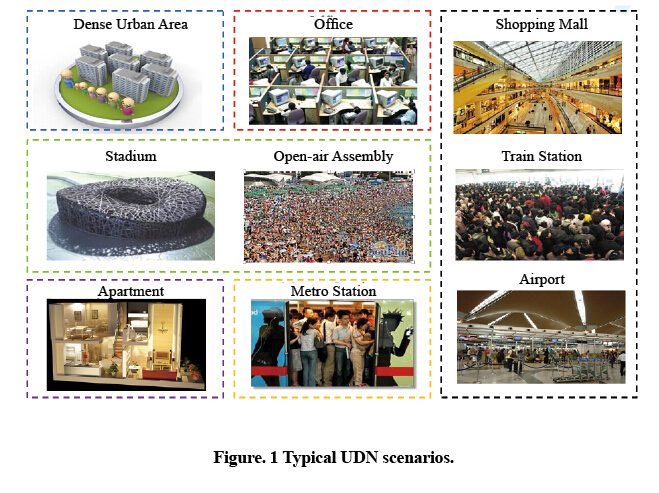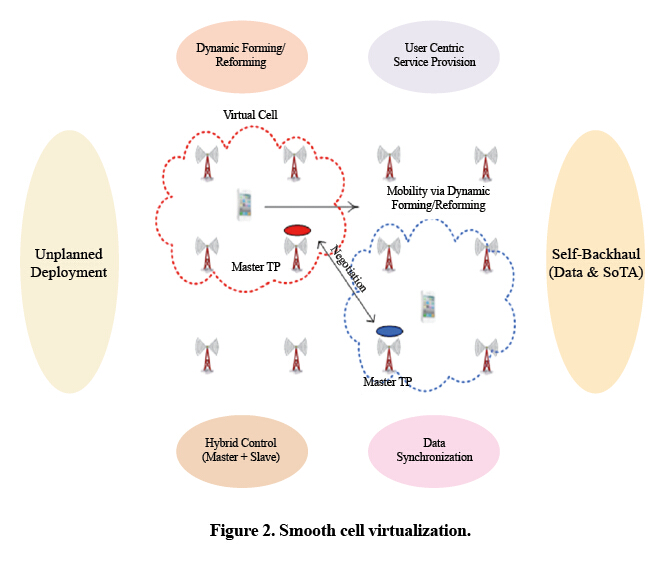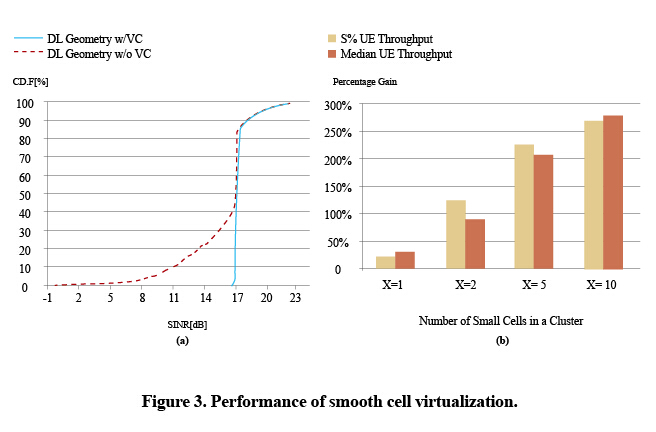Ultra Dense Network in 5G
Outline of UDN
Recent years have seen tremendous growth in mobile data traffic, and this trend is expected to continue in the near future. To cope with this growth, dense transmission points (TPs), e.g., ultra-dense networks (UDNs), need to be deployed. Fig. 1 shows six typical UDN scenarios identified by the IMT-2020 (5G) Promotion Group (China).

Cell-Edge Effect
Densifying TPs creates many challenges, such as cell-edge effect, where mobility and interference are negatively affected. CoMP in LTE, soft handover in CDMA, and fast cell selection in WiMAX have been proposed to address this issue. However, they may not work well in a future network, and deploying a dense small cell network with ideal backhaul becomes more and more difficult. Therefore, the idea of smooth cell virtualization with hybrid control mechanism is proposed. It is an effective way to deal with mobility and interference issue for UDN.
What is Smooth Cell Virtualization?

Fig. 2 shows smooth cell virtualization. Several TPs around a user form a smooth virtual cell (SVC) to provide user-centric service. One master TP is selected to control working procedure of the corresponding SVC. Master TPs between different SVCs negotiate with each other on resource allocation so as to enable harmonious coexistence of different SVCs. Because TPs involved in the control circle are in proximity, fast control for dynamic forming/reforming of SVC and negotiation are possible. In addition, signaling via self-backhaul or signaling over the air (SoTA) can further reduce latency on control signaling and make the virtual cell more efficient.
Benefit of Smooth Cell Virtualization

Simulation shows the effectiveness of a uniform user experience. The red curve in Fig. 3a shows the cumulative distribution function (CDF) of downlink SINR of a UE in different locations without user-centric service provision. The SINR ranges from-1 dB to 22 dB, and the user has a very different experience in different locations. The blue curve in Fig. 3a shows the CDF of downlink SINR with user-centric service provision. If user-centric service is provided via cell virtualization and TPs are dynamically muted at the desired resources of a target UE, SINR can be kept to a target level of about 17 dB as it moves around. Gain from interference mitigation via SVC is shown in Fig. 3b.
Devices are also expected to be densified in the future. Recently, wearable devices have become popular. Users may own more than one device with demand for data connection and supporting direct communication among devices. Multiple devices can be grouped as a virtual user. Virtualization on user terminals can also mitigate interference and simplify resource allocation on the network side.
Self-Backhaul
Backhaul is another key issue associated with the increased cell density. Self-backhaul is cost-effective because it doesn’t require any cable connection but supports unplanned or semi-planned deployment as well as spectrum and RAT sharing with access link. Moreover, self-backhaul ensures link quality by using licensed spectrum and joint optimization with access link. Self-backhaul nodes can also provide traffic offloading and prominent cell split gain in densely deployed networks by applying content prediction and caching techniques.
There are many potential enhancements to self-backhaul. MIMO is a powerful method for increasing link efficiency of self-backhaul by exploiting additional spatial degree of freedom or diversity gain. A scheme exploiting massive MIMO is studied and remarkable gain can be observed. Joint resource allocation and optimization between the backhaul link and access link is an attractive way of increasing radio resource efficiency and self-backhaul capacity. Flexible resource allocation between uplink and downlink can also be considered to make full use of radio resource by exploiting the feature of uplink and downlink traffic fluctuation.
Besides high capacity, the design of UDN should also consider other 5G requirements, such as content diversity, low-latency highly-reliable communication, and massive machine communication. How to coexist with mmWave and eSON and to exploit output from the IT field is worthy of in-depth study. Making full use of millions of WiFi APs via multi-RAT and intelligently mapping content between different RATs will significantly enhance network performance.
UDN is an important way that operators can meet the 5G requirement on data volume per area. ZTE has proposed smooth cell virtualization and self-backhaul to solve problems such as cell edge effect and flexible deployment in UDN and delivers an efficient ultra dense network with fantastic user experience.